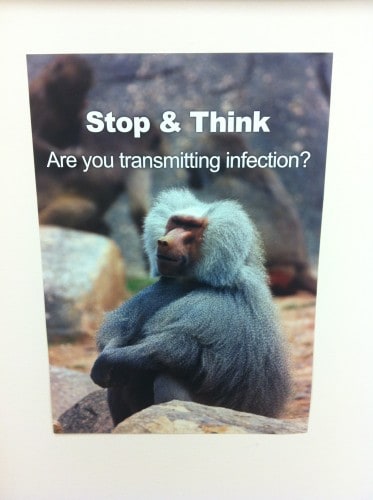The more I visit different hospitals, the more I tend to roll my eyes at the different signs that aim to remind staff and/or visitors to follow proper hand hygiene practices. These signs are often part of an arms race (among sign manufacturers, I presume) to see whose signs can be the cutest or most clever. I've seen signs that include:
- Kittens
- Babies
- Cartoon microbes
- Puppies
As I've written about before (“My Anti-Handwashing-Poster Poster“), these signs might be well intended, but I think they miss the point. If signs and reminders worked, we would have solve the hand hygiene “compliance” challenge long ago. But thanks to an anonymous reader, I have a new sign to add to the collection… involving a monkey – a sign that was hanging in a public corridor (“part of a series of different monkey posters,” says the emailer).
Maybe that's more of a baboon than a monkey? I don't know. But it doesn't look like hospital staff members I know. I'm not sure if apes wash their hands (zoologists, chime in?). They're purported to fling poo at each other to mark their territory. So, yeah, that probably spreads infection… but the lesson for hospital staff members?
Amongst all of the other reminders about hand washing, it seems this sign might be the most troublesome or offensive. What's the thought process of the person hanging the signs? I really don't understand how this sign would help. Even a more direct sign like this one makes sense, but might not lead to 100% compliance.
Instead of lecturing, embarrassing, or haranguing staff and physicians, I'd argue that hospital leaders should follow Lean leadership practices, including:
- Leaving the office to go to the “gemba,” or the place where work is done (or where patient care is provided)
- Talk with staff members to collaborative identify barriers to hand hygiene, working together on countermeasures
Instead of blaming, work together. Do you need to hang more gel dispensers? Do you need to help eliminate waste from the workday so staff members have enough time to follow proper hand hygiene practices? Can you physically error proof the process (as was done in this video)?
If you have cute or lecturing signs in your hospital, send it to me via email (mark at leanblog dot org) and I'll post it anonymously in this post.
Patients and the public are becoming more aware of hospital acquired infections – the sheer number of them that occur and how preventable they can be. Maybe patients, in the future, will be more impressed with data and infection prevention results than they will be by signs in the hallways?
Please scroll down (or click) to post a comment. Connect with me on LinkedIn.
Let’s work together to build a culture of continuous improvement and psychological safety. If you're a leader looking to create lasting change—not just projects—I help organizations:
- Engage people at all levels in sustainable improvement
- Shift from fear of mistakes to learning from them
- Apply Lean thinking in practical, people-centered ways
Interested in coaching or a keynote talk? Let’s start a conversation.











I was unprepared to read a lean post this morning with the phrase “fling poo” in it, but . . . .
I began to include signs in our lean orientation for similar reasons. Signs never seem to address the root cause and are ignored after the first few days (maybe hours).
Good post for the morning. Thanks.
Assuming they are putting up the signs because there was an apparent problem with hygiene, they clearly knew well enough to recognize the need to do something-and this was it? Either the problem is not truly a problem, hence the lackadaisical approach, or there is a serious issues that needs to be addressed with more than a cute sign.
And it is pretty cute.
Nice post!
One way to prevent the non-washing of hands would be to have a central restroom exit with a soap-dispensing gate/turnstile and sink outside the turnstile. Exiting bathroom users put their hands in a soap-dispensing laser-detection box that won’t unlock the turnstile until soap is on their hands. Users then walk to the sink to finish washing their hands. This has been incorporated at the Ohio plant of The Dannon Company (the yogurt manufacturer) and works very well. (There are ways around it – always room for improvement!)
Chad – yes, that’s an example of an attempt at error proofing that process. In a hospital, the general rule of thumb is to gel your hands going in or out of any patient room, on entering or leaving a unit, before or after contact with a patient… so attempts at mechanical error proofing might be very expensive to do that all throughout a hospital… but thanks for sharing the example from Dannon!
Remember that Dr. Deming said that posters and exhortations do not work to improve quality.
Exactly. Amen to that. I should have referenced Dr. Deming in the post!
Not sure I understand the antipithy towards signs that are friendly reminders of good habits. I don’t think anyone would expect a sign to create 100% compliance, but if it helps remind someone to perform a simple but important task, how can that be a bad thing?
I do agree that signs should not embarrass, offend, or shock employees. Employees should be treated like adults. And Deming was right…slogans on signs like “Safety Starts With You” do nothing, but I think there’s a difference between reminders to peform simple tasks and big slogans that attempt to create a culture of behavior.
Perhaps the signs are more for visitors to hospitals than employees? Perhaps visitors are more prone to skipping handwashing after visiting a washroom?
My strongest objection to signs/posters comes when managers think “my work here is done” after posting a sign. I think the signs are more of a symptom of a problem (something that isn’t happening) more than a lock tight solution.
I am more tolerant of signs when they are educational for visitors or patients (but I wouldn’t use apes). The issue for nurses, doctors, and staff members isn’t lack of awareness. If they are truly “forgetting” to do hand hygiene, I would be surprised. It’s more a matter of “lack of time” or it being too difficult to do. That’s where I don’t think signs help. If signs were wholly sufficient, hand hygiene compliance rates wouldn’t be so low.
Let’s look at another example – a nursing unit is supposed to do narcotic counts every 12 hours to make sure these dangerous meds aren’t stolen or missing. Management might hang a sign that says “don’t forget to do narcotic counts” but that is hardly the proper management of that process. Fast food restaurants do a better job of managing the hourly cleaning of bathrooms – they might have a check sheet and that sheet has to be actively managed. If the narcotic count isn’t happening, how do we manage that? Is the time to do the narcotic count designed into somebody’s day and job responsibilities, or are we asking “everyone” to do it (which means “no one” is accountable)? These signs often just blame the staff instead of looking at the real system factors involved.
The hand washing signs are often the most visible instance of the “we hung a sign, therefore it’s fixed” thinking that seems pretty prevalent.
That flinging poo idea might just be them spreading some beneficial bacteria around the community :-) http://blogs.wsj.com/health/2011/10/31/fecal-transplants-have-the-ick-factor-but-research-suggests-they-work/
Medicine has so many interesting illustrations of systems thinking, like using leeches that are not very “high tech” but do some jobs very well. That importance of systems thinking in medical care led me to think health care would adopt Deming’s ideas fairly easily (this was before “lean” had been coined as a term) – a long time ago. Sadly it did not work out that way. Thankfully the adoption of lean ideas in health care has been moving forward more positively lately. Still way way way too slowly for me – but I always want things to be better.
Also from the title I was actually thinking the post was going to talk about the positive affect of animals on recovery. Some hospitals have cats… for patients. I like these ideas – again addressing the whole person, not just their chemical reactions to the chemical drugs we put into them… I figured babies have a similar positive affect on many people. I wasn’t so sure about monkeys.
Interesting blog post in the New York Times, with a more technology-driven approach to oversight:
http://opinionator.blogs.nytimes.com/2011/11/24/an-electronic-eye-on-hospital-hand-washing/?src=twr
I’d still rather discuss the underlying root causes of why staff are “harried” to begin with.
A comment I posted in NYT (but hasn’t been approved):
It’s interesting to see the progress of technologies like this. It’s great to see the results that came from the pilot. I’d argue that it’s likely a big part of the success here is due to the non-punitive environment for this test.
Regardless of the technology used, it’s also important to look at the underlying root causes of why staff members are “harried.” Why don’t nurses and staff have enough time in their day to the point where they “forget” or have to cut corners on hand hygiene?
The “lean” improvement methodology drives us to improve processes so waste is eliminated and staff have more time to do the right things – including hygiene. When we do simple things like organize utility rooms and ensure that staff can find supplies, equipment, and medications without a ton of “hunting and gathering,” then we have saved hours from the nurse’s day. ThedaCare, a leading “lean hospital” in Wisconsin reduced the time nurses spent searching for stuff from 3 to 4 hours per day to just one hour. Think of what you can do with all of that freed up time!
see the 2010 NYT article on Seattle Children’s Hospital for more on this:
https://www.leanblog.org/2010/07/lean-healthcare-featured-in-sunday-ny-times-business-page/
Maybe it actually IS a lack of education about hand hygiene? Who knew?
http://www.medicalnewstoday.com/releases/238581.php
“2 Out Of 3 Medical Students Do Not Know When To Wash Their Hands”
Here is a follow up, standalone article I wrote on this topic for Quality Digest:
http://www.qualitydigest.com/inside/health-care-article/improving-health-care-quality-through-signs-or-systems.html
[…] don’t think any number of cute posters or buttons for staff to wear are going to solve the patient safety crisis (yes, it’s a […]
[…] Hanging more posters and cuter signs doesn’t work… lack of hygiene is not an education or awareness issue – it’s a systems, processes, and leadership issue. […]
[…] Improving safety requires culture change and leadership. Safety isn’t improved with signs and […]